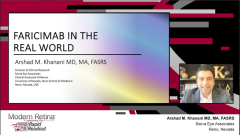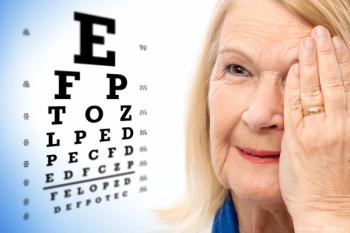
Learnings from Real World Evidence of Faricimab in nAMD and DME: Part 1
Arshad M. Khanani, MD, MA, FASRS, discusses rapid improvement with faricimab in several anatomic parameters in treatment-naïve and previously treated patients with nAMD and DME in the TRUCKEE and TAHOE studies.
Episodes in this series
Arshad M. Khanani, MD, MA, FASRS: Hi, I’m Arshad Khanani, director of clinical research at Sierra Eye Associates, as well as a clinical associate professor at the University of Nevada, Reno School of Medicine. At the recent [23rd Euretina Congress] in Amsterdam, I gave an invited talk on faricimab in the real world to share our experience with it in neovascular AMD [age-related macular degeneration; nAMD] as well as DME [diabetic macular edema] since the FDA approval in February of 2022.
So why do we need [those] real-world data? I think it’s an important point because clinical trials obviously have inclusion-exclusion criteria. And sometimes the clinical trial population is very homogeneous, and we don’t know how the drug or any drug that comes to market will work in terms of efficacy. And what will be the safety when we inject a large number of patients in the real world [who] are very different than [those in the] clinical trial? So for faricimab, the phase 3 TENAYA and LUCERNE studies included naïve patients with [nAMD]. So, we don’t have any switch data from the faricimab clinical trial program in terms of how patients do when they switch from another anti-VEGF [therapy] to faricimab. And also, for the DME study, most of the patients were also naïve. And the ones [who] were previously treated had to have a washout, so again, we don’t have [many] switch data for patients with DME from the faricimab program. And then of course, I mentioned safety…clinical trial patient population because of specific inclusion and exclusion [criteria] may behave differently compared [with] when we use the drug in the real world.
In terms of real-world evidence that we have since approval of faricimab, you can see that there [are] many studies that have been done looking at evidence generation to see how faricimab is performing in the real world. And I think to summarize the work that has been listed here, I think [the] majority of the studies are showing that faricimab in neovascular AMD and DME is associated with improved anatomy as well as vision in many of these studies. Also, there is some hint of durability based on the large database analysis, the FARETINA as well as FARWIDE studies.
So, what are the learnings? I presented the 10 learnings from our experience, running the TRUCKEE and TAHOE studies, which I will go into a little bit later. And so, the first main learning is that a single injection of faricimab results in rapid improvement in all anatomic parameters. We are looking at IRF [intraretinal fluid], SRF [subretinal fluid], PED [pigment epithelial detachment] in treatment-naïve and previously treated patients with neovascular AMD and DME. Well, what is the evidence? So, looking at the TRUCKEE study, as you recall, it’s a collaborative, non–pharma supportive, physician-driven study that we started early last year, right after the approval of faricimab to generate real-world data for our colleagues around the world. And what we have seen is that when you look at the efficacy after 1 injection of faricimab in treatment-naïve patients, we have seen rapid improvement in anatomy as highlighted by CST [central subfield thickness] and PED reductions. And of course, a trend toward increased vision, because these are naïve patients. [These are] the data from 145 eyes.
Now let’s look at the switch data, right? We don’t have any switch data from [the] TENAYA and LUCERNE [studies]. [These are] the data from 2250 eyes in the TRUCKEE study. And what we see after 1 injection of faricimab is significant improvement in anatomy with decrease in CST as well as PED height. One thing to highlight is that the interval before faricimab was 46.6 days and the follow-up interval was 49.5 days. So, it’s a similar interval that you’re seeing improvement in anatomy. And of course, the vision is stable. We don’t expect much vision improvement due to these patients being previously treated.
What about TAHOE? TAHOE is a study we launched for real-world evidence in DME. Of course, it started much after TRUCKEE, so the number of patients [is] much less at this point, but we’ll continue to generate data. We have 140 eyes in TAHOE after 1 injection. Again, we see improvement in CST. These are patients with DME and again, similar interval before and after, but the surprising part was the interval in terms of AMD was about 45 days or so. Here’s about 100 days telling us that [patients with DME] don’t come in as often because of other things they have happening in terms of their health as well as [nonadherence]. So that was a surprise for us, but other than that, the anatomy is improved after 1 injection at the same time interval.
Here’s a case that is from my clinic: [a patient with] bilateral neovascular AMD…active disease in both eyes with IRF, SRF, PEDs, also a hemorrhage in the right eye, visual acuity 20/15 right eye, after a single injection, rapid improvement in anatomy with 20/25 vision in the right and the left eye 20/25 stable vision with significant improvement in anatomy with almost resolution of PED and no fluid. So really showing the power of dual inhibition of VEGF-A as well as Ang-2. This is a [patient with DME] from my clinic, naïve…severe vision loss, severe disease. Again, after a single injection of faricimab, you can see significant improvement in anatomy. Of course, we have a photoreceptor and ellipsoid zone changes here. So, the visual acuity improved, but not as much, but this wasn’t unexpected, but the idea that with dual inhibition, we are able to control disease rapidly.
What is learning [No.] 2? Most patients switching from aflibercept 2 mg to faricimab experience reduction in anatomic parameters along with stable or improved vision with the potential of extended treatment intervals in both nAMD and DME. Here’s the evidence from [the] TRUCKEE study: 1007 eyes switched from aflibercept to faricimab. You see again improvement in anatomic parameter and stable visual acuity against similar interval before and after faricimab. In terms of resolution of fluid, you can see percent of patients with improved or resolution of IRF and SRF. In naïve, all switch, and aflibercept switch, you see a pretty good consistent trend that after 1 injection of faricimab, there’s a good number of patients, anywhere from 25% to 30%, [who] have resolution of their IRF and SRF.
What about efficacy after 6 injections? These are not 6 monthly injections, just 6 injections given in [the] TRUCKEE real-world study. We have 219 eyes, and what we see [is] that these are switched from aflibercept, and we see almost 50 [µm] improvement in CST, which is very clinically significant in these patients who are on frequent treatments of aflibercept before switching to faricimab. And the visual acuity is stable, really showing us that continuous treatment with faricimab leads to even better anatomy. This is a previously treated patient of mine with diabetic macular edema, history of bevacizumab, ranibizumab, and aflibercept injection. On the left, you can see intraretinal fluid, 20/50 vision, a patient received last aflibercept on January 9. This is an OCT from February 6. So really less than a month in terms of follow-up, and you can see after switching to faricimab, not only the fluid is gone, actually we’re able to extend the patient right away to 6 to 8 weeks, And we see improvement in visual acuity on [the] June 17 visit to 20/25 vision, again, showing that dual inhibition can help patients who have chronic or persistent disease.
Transcript is AI-generated and edited for clarity and readability.
Newsletter
Get the essential updates shaping the future of pharma manufacturing and compliance—subscribe today to Pharmaceutical Technology and never miss a breakthrough.













































